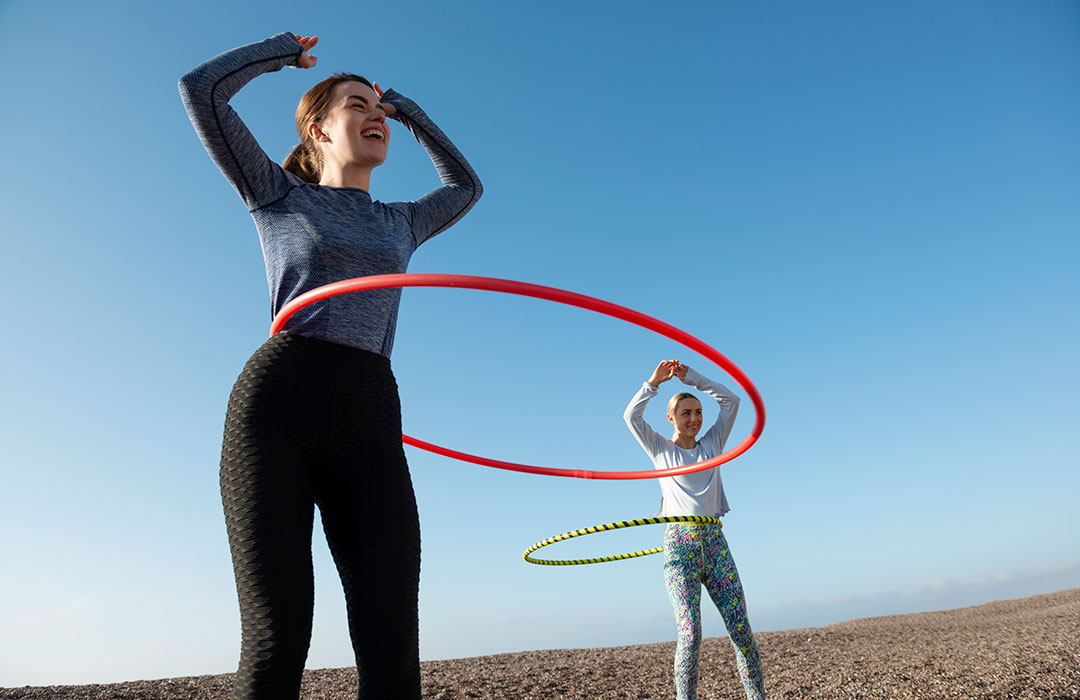Are you tired of the same old workout routine that feels more like a chore than a fun activity? Look no further than hula hooping – a delightful and effective workout that will have you feeling like a kid again! Hula hooping is not just a pastime for children; it has gained popularity among adults as a fun and engaging way to burn calories, tone muscles, and improve cardiovascular health. This low-impact exercise can be enjoyed by individuals of all fitness levels, making it a versatile option for anyone looking to switch up their fitness routine. Whether you’re a beginner or an experienced fitness enthusiast, hula hooping offers many benefits, including improved coordination, increased flexibility, and enhanced core strength. So, grab a hoop and get ready to experience the joy and health benefits of hula hooping – it’s time to embrace a workout that genuinely makes you feel alive!
Health Benefits of Hula Hooping
Hula hooping is more than just a fun activity – it also offers many health benefits. Firstly, hula hooping is a great way to burn calories and lose weight. According to a study by the American Council on Exercise, hula hooping can burn up to 600 calories per hour, making it a highly effective workout for weight loss. The continuous movement of the hoop engages your core muscles, as well as your arms and legs, resulting in a full-body exercise that torches calories and helps you shed those extra pounds.
In addition to weight loss, hula hooping also improves cardiovascular fitness. The rhythmic motion of hooping gets your heart pumping and increases your heart rate, similar to aerobic exercises like running or cycling. Regular hula hooping can improve your cardiovascular endurance, strengthen your heart, and lower your risk of heart disease. Plus, it’s a fun way to get your heart rate up without the monotony of traditional cardio exercises.
Furthermore, hula hooping is an excellent way to strengthen your core muscles and improve stability. The constant movement of the hoop forces your abdominal muscles to engage and work hard to keep the circle spinning around your waist. This helps tone your abs, strengthens your lower back, and improves your posture. By incorporating hula hooping into your fitness routine, you’ll develop a stronger core, essential for maintaining overall strength and stability.
Calorie Burn and Weight Loss with Hula Hooping
Hula hooping is a highly effective workout for burning calories and achieving weight loss. It is estimated that hula hooping can burn up to 600 calories per hour, depending on your body weight and the intensity of the workout. This makes it comparable to other high-intensity exercises such as running or cycling. The continuous movement of the hoop engages not only your core muscles but also your arms and legs, resulting in a full-body workout that helps you shed those extra pounds.
Maintaining a consistent and rhythmic motion is the key to maximizing calorie burn and weight loss with hula hooping. Start by standing with your feet shoulder-width apart and place the hoop around your waist. Please give it a good spin and begin rocking your hips back and forth to keep the ring in motion. As you become more comfortable, you can experiment with different moves, such as waist hooping, chest hooping, or even hooping on your arms and legs. The more you challenge yourself, the more calories you’ll burn.
Consider incorporating interval training to make your hula hooping workouts even more effective for weight loss. Alternate between high-intensity bursts of hooping, where you spin the hoop as fast as you can, and lower-intensity recovery periods. This type of training, known as high-intensity interval training (HIIT), has been shown to boost metabolism and increase calorie burn even after your workout. By combining hula hooping with interval training, you’ll be well on your way to achieving your weight loss goals.
Hula Hooping for Cardiovascular Fitness
If you want to improve your cardiovascular fitness, hula hooping is a fantastic option. The continuous movement of hooping increases your heart rate, similar to aerobic exercises like running or cycling. When you hoop, your heart must work harder to pump blood to meet the increased demand, strengthening your heart muscle and improving overall cardiovascular health.
Aim to maintain moderate intensity throughout your workout to get the most cardiovascular benefits from hula hooping. This means hooping at a pace that elevates your heart rate but allows you to continue a conversation without gasping for breath. Start with a warm-up of a few minutes of gentle hooping, gradually increasing the intensity as your heart rate rises. Once you’re in the target heart rate zone, maintain the pace for at least 20 to 30 minutes to reap the maximum cardiovascular benefits.
One of the great things about hula hooping is that you can easily tailor the intensity to suit your fitness level. If you’re a beginner or have a lower level of fitness, start with shorter intervals of hooping and gradually build up your endurance. As you become more comfortable, you can increase the duration of your workouts and even incorporate more challenging moves or add weights to your hoop for an extra challenge. The key is to listen to your body and gradually progress at a comfortable pace.
Improving Core Strength and Stability with Hula Hooping
Hula hooping is a fun and enjoyable workout and a fantastic way to strengthen your core muscles and improve stability. When you hoop, your core muscles, including your abdominal muscles, obliques, and lower back, must work hard to keep the hoop spinning around your waist. This constant engagement of the core muscles helps tone and strengthen them, improving core strength and stability.
Maintaining proper form throughout your workout to get the most out of hula hooping for core strength. Stand with your feet shoulder-width apart and engage your core by pulling your belly button towards your spine. This will activate your abdominal muscles and create a solid foundation for hooping. As you spin the hoop, be mindful of your posture and avoid leaning forward or backward. Instead, keep your spine straight and tall, and let your hips move the hoop.
As your hula hooping journey progresses, consider incorporating different moves and challenges targeting your core muscles. For example, you can try hooping on one leg or incorporate side-to-side movements to engage your obliques. You can also experiment with hooping in different planes, such as hooping on your chest or arms, to further challenge your core stability. You’ll strengthen your core muscles and improve your overall balance and strength by continually challenging them.
Hula Hooping for Flexibility and Coordination
In addition to its physical benefits, hula hooping is an excellent way to improve flexibility and coordination. The continuous movement of hooping requires you to move your body in various directions, which helps increase your range of motion and flexibility. You’ll stretch and lengthen your muscles as you hoop, particularly those in your waist, hips, and lower back, improving flexibility.
To enhance the flexibility benefits of hula hooping, consider incorporating dynamic stretches into your warm-up routine. Before you start hooping, spend a few minutes performing plays that target the muscles you’ll be using, such as side bends, hip circles, and torso twists. This will help prepare your body for the range of motion required during hooping and reduce the risk of injury.
In addition to flexibility, hula hooping also improves coordination. When you hoop, you have to synchronize the movements of your hips, arms, and legs to keep the hoop spinning. This requires hand-eye coordination and coordination between different parts of your body. As you practice and become more proficient in hooping, you’ll notice improved coordination and motor skills, which can translate to better performance in other physical activities.
Hula Hooping for Stress Relief and Mental Well-being
Beyond its physical benefits, hula hooping is also a fantastic way to relieve stress and improve mental well-being. Engaging in an enjoyable activity like hooping can help reduce stress levels by releasing endorphins, natural feel-good hormones. As you hoop, you’ll experience a sense of joy and playfulness, allowing you to escape from the daily stresses of life and focus on the present moment.
Hula hooping can also serve as a form of meditation, as the rhythmic movement of hooping can help quiet the mind and promote mindfulness. As you spin the hoop around your body, please focus on the sensation of the hoop against your skin, the sound it makes as it turns, and the rhythmic flow of your movements. This mindfulness practice can help calm the mind, reduce anxiety, and improve overall mental well-being.
Consider creating a dedicated space for your workouts to enhance the stress-relieving benefits of hula hooping. Whether in your backyard, a local park, or even your living room, having a designated area for hooping can help create a sense of tranquility and make your workouts more enjoyable. You can also play your favorite music or listen to calming nature sounds further to enhance the relaxation and stress-relief benefits of hula hooping.
Different Types of Hula Hoops and Which One to Choose
When it comes to hula hooping, not all hoops are created equal. Different types of hula hoops are available, each with its own characteristics and benefits. Here are some of the most common types of hula hoops and how to choose the right one for you.
Traditional Hula Hoops
These classic hula hoops are typically made of plastic and come in various sizes. Traditional hula hoops are lightweight and easy to maneuver, making them suitable for beginners. They are also more forgiving and easier to keep spinning, making them a good choice for those just starting.
Weighted Hula Hoops
Weighted hula hoops are heavier than traditional hoops designed to provide more resistance during workouts. The added weight challenges your muscles and makes your hooping sessions more intense. Weighted hoops are an excellent choice for those looking for a more challenging workout or individuals with more experience in hula hooping.
Fitness Hula Hoops
Fitness hula hoops are similar to weighted hoops but often have a padded or textured surface for added grip and comfort. These hoops are designed specifically for fitness purposes and are often used in hula hoop classes or workouts. Fitness hoops typically come in various weights and sizes to accommodate different fitness levels and body types.
When choosing a hula hoop, it’s essential to consider your skill level, fitness goals, and body type. If you’re a beginner, start with a traditional hoop to get the hang of hooping and build your skills. As you progress, you can gradually transition to a weighted or a fitness hoop to add more challenges to your workouts. Choosing a hoop that is the right size for you is also important. Ideally, the hoop should reach your waist when standing upright. If the hoop is too small, it will be challenging to keep it spinning; if it’s too large, it may be challenging to control.
Hula Hooping Techniques and Moves for Beginners
Learning basic techniques and moves can help you start your hooping journey if you’re new to hula hooping. Here are some beginner-friendly methods to try:
Waist Hooping
Waist hooping is the foundation of hula hooping and the most common move. To waist hoop, stand with your feet shoulder-width apart and place the hoop around your waist. Give it a good spin and begin rocking your hips back and forth to keep the hoop in motion. Finding the right rhythm may take some practice, but with time, you’ll be able to keep the hoop spinning effortlessly.
Hand Hooping
Hand hooping involves moving the hoop up and down your arms or spinning it around your hands. Start by holding the hoop in front of you with both hands and give it a spin. As the hoop starts to rotate, move your hands up and down to keep it in motion. You can also experiment with different arm movements, such as waving or crossing your arms, to add variety to your hand hooping.
Off-Body Tricks
Off-body tricks are moves where the hoop leaves your waist and is spun around other body parts, such as your arms or legs. Some popular off-body tricks include arm hooping, leg hooping, and chest hooping. To learn off-body tricks, start by mastering waist hooping and then gradually introduce new moves. Practice each movement slowly and focus on maintaining control and rhythm.
Remember, learning hula hooping takes time and practice, so don’t get discouraged if you don’t master the moves right away. You’ll soon become more comfortable and proficient in hooping with consistent effort and perseverance. It’s all about enjoying the process and having fun!
Advanced Hula Hooping Tricks and Challenges
Once you’ve mastered the basics of hula hooping, you can challenge yourself with more advanced tricks and moves. These moves require more skill and coordination but can add excitement and variety to your hooping workouts. Here are some advanced hula-hooping tricks to try:
Vertical Hooping
Vertical hooping involves spinning the hoop in a vertical plane rather than horizontally around your waist. To do this, hold the hoop vertically in front of you and give it a spin. Move your body back and forth to keep the hoop in motion. This move requires precise control and coordination and may take some time to master.
Isolation
Isolation is a mesmerizing move where the hoop floats mid-air without any visible movement. To perform isolation, start by spinning the hoop around your waist. Gradually slow down the hoop until it comes to a stop. With your hands, gently push the hoop in one direction, causing it to rotate around your body without touching it. This move requires a great deal of control and finesse.
Twin Hooping
Twin hooping is an advanced hula hooping technique that involves spinning two hoops simultaneously. This impressive move can be performed by spinning both hoops around your waist or hooping on different body parts, such as your waist and arms. Twin hooping requires a high level of coordination, as you must synchronize the movements of both hoops while maintaining control and rhythm. It’s a challenging but rewarding skill to master, adding an exciting element to your hula-hooping repertoire. With practice and patience, you can wow your friends and take your hooping skills to the next level with twin hooping.
-
Is hula hooping suitable for all fitness levels?
Yes, hula hooping is a versatile workout that individuals of all fitness levels can enjoy. Beginners can start with basic moves and gradually progress to more advanced techniques as they build their skills and strength.
-
Can hula hooping help with weight loss?
Yes, hula hooping is an effective workout for burning calories and losing weight. It can burn up to 600 calories per hour, depending on body weight and workout intensity.
-
Do I need a specific type of hula hoop for hooping?
Different types of hula hoops are available, including traditional hoops, weighted hoops, and fitness hoops. Beginners can start with a traditional hoop and transition to a weighted or fitness hoop as they advance. Choosing a hoop that suits your skill level, fitness goals, and body type is essential.
-
How long should I hoop to see the results?
Consistency is key. Aim for at least 20 to 30 minutes of hooping per session, several times a week, to see noticeable results in weight loss, improved cardiovascular fitness, core strength, and coordination. However, any amount of hooping is beneficial, so start with a duration that feels comfortable for you and gradually increase it over time.
-
Can hula hooping improve flexibility?
Yes, hula hooping involves various movements that help increase the range of motion and flexibility, particularly in the waist, hips, and lower back. Incorporating dynamic stretches into your warm-up routine can further enhance flexibility benefits.
Conclusion
Hula hooping offers a fun and effective workout that individuals of all fitness levels can enjoy. Whether you want to burn calories, lose weight, improve cardiovascular health, strengthen your core, enhance flexibility, or boost coordination, hula hooping provides many physical and mental benefits. With consistent practice and gradual progression, you can master basic techniques and challenge yourself with more advanced tricks. So, grab a hoop, embrace the joy of hooping, and experience a workout that energizes your body and brings out your inner child!




